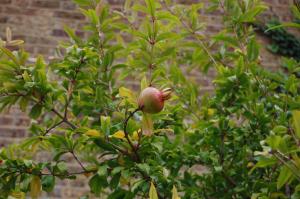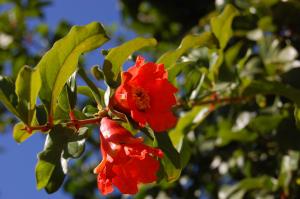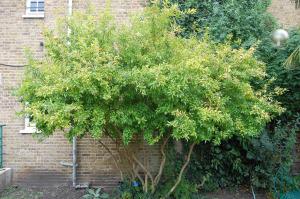
Punica granatum fruit (16/10/2011, London)
Position: Full sun to
Flowering period: Spring to early summer
Soil: Moist
Eventual Height: 6m
Eventual Spread: 6m
Hardiness: USDA Zones 7b – 11
Family: Punicaceae
Punica granatum is a fruit bearing deciduous shrub or small tree with bushy growth habit. The leaves of the plant are opposite or sub-opposite and glossy. The are also narrow and quite oblong, being entire. They are 3 – 7 cm long and 2 cm broad. The flowers are showy, they are 3 centimeters wide and are characterized by a thick, tubular, red calyx from which emerge the 3 to 7 crinkled red, white or variegated petals, which enclose the numerous stamens. The edible fruit is a berry and is between a lemon and a grapefruit in size. It is 5 – 12 centimeters in diameter with a rounded hexagonal shape, and has thick reddish skin and around 600 seeds. Each seed has a surrounding water – laden pulp, and are embedded in a white, spongy, astringent pulp.

Punica granatum flower (Athens, Greece, 22/08/2011)
Punica granatum, commonly known as the Pomegranate, is native to Iran. It has been cultivated in the Caucasus since ancient times, and today is widely cultivated throughout Iran, Azerbajjan, Armenia, Afghanistan, India, Iraq, Israel, Jordan, Chine, Saudi Arabia and Egypt. It is also cultivated in the region of Southern Europe and tropical Africa. It was introduced into Latin America and California by Spanish settlers in 1769. This plant has been mentioned in many ancient texts, notably the Homeric Hymns, which celebrate individual Gods. It also is mentioned in the Book of Exodus in the Bible and is valued by many cultures for it’s beauty and uniqueness. It is believed the the Pomegranate was the Forbidden Fruit in the Garden of Eden.
The etymological root of the binomial name Punica is derived from the Latin name for the ‘Carthaginian apple’ punicum malum, an early name for pomegranate. Granatum is derived from the Latin meaning ‘many seeded’.

Punica granatum (16/10/2011, London)
The landscape architect may find Punica granatum useful for city, courtyard garden schemes, where it is protected from cold winds. It is also tolerant of the maritime climate and drought conditions.
Ecologically this plant is both self – pollinated and cross – pollinated by insects. The pomegranate butterfly, Virachola isocrates, is reliant on this plants fruit for the developmet of its larvae.
P. granatum is able to tolerate compacted soils and seasonal water-logging. It prefers fertile, well drained soils and is tolerant of most pH soils. It is also drought tolerant
Maintenance: This plant requires little maintenance. Prune as little as possible in order to maintain its characteristic growth habit.

